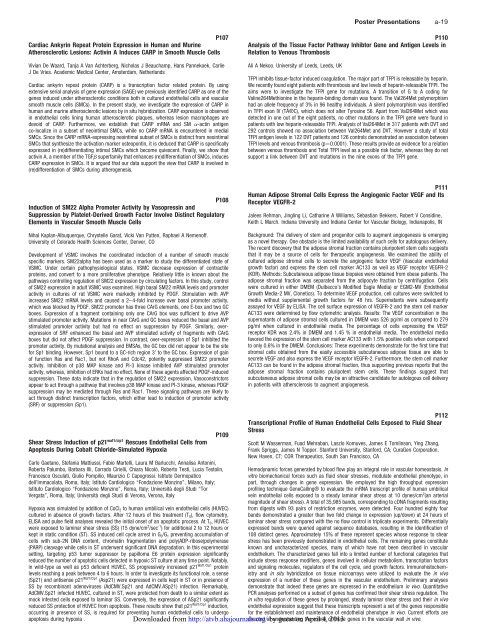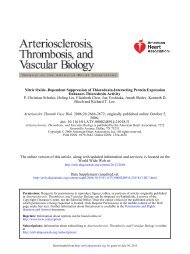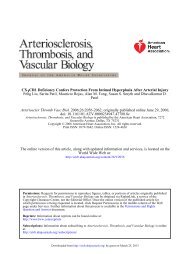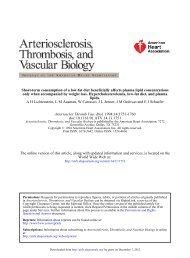Oral Presentations - Arteriosclerosis, Thrombosis, and Vascular ...
Oral Presentations - Arteriosclerosis, Thrombosis, and Vascular ...
Oral Presentations - Arteriosclerosis, Thrombosis, and Vascular ...
Create successful ePaper yourself
Turn your PDF publications into a flip-book with our unique Google optimized e-Paper software.
P107<br />
Cardiac Ankyrin Repeat Protein Expression in Human <strong>and</strong> Murine<br />
Atherosclerotic Lesions: Activin A Induces CARP in Smooth Muscle Cells<br />
Vivian De Waard, Tanja A Van Achterberg, Nicholas J Beauchamp, Hans Pannekoek, Carlie<br />
J De Vries. Academic Medical Center, Amsterdam, Netherl<strong>and</strong>s<br />
Cardiac ankyrin repeat protein (CARP) is a transcription factor related protein. By using<br />
extensive serial analysis of gene expression (SAGE) we previously identified CARP as one of the<br />
genes induced under atherosclerotic conditions both in cultured endothelial cells <strong>and</strong> vascular<br />
smooth muscle cells (SMCs). In the present study, we investigate the expression of CARP in<br />
human <strong>and</strong> murine atherosclerotic lesions by in situ hybridization. CARP expression is observed<br />
in endothelial cells lining human atherosclerotic plaques, whereas lesion macrophages are<br />
devoid of CARP. Furthermore, we establish that CARP mRNA <strong>and</strong> SM -actin antigen<br />
co-localize in a subset of neointimal SMCs, while no CARP mRNA is encountered in medial<br />
SMCs. Since the CARP mRNA-expressing neointimal subset of SMCs is distinct from neointimal<br />
SMCs that synthesize the activation marker osteopontin, it is deduced that CARP is specifically<br />
expressed in (re)differentiating intimal SMCs which become quiescent. Finally, we show that<br />
activin A, a member of the TGF superfamily that enhances (re)differentiation of SMCs, induces<br />
CARP expression in SMCs. It is argued that our data support the view that CARP is involved in<br />
(re)differentiation of SMCs during atherogenesis.<br />
P108<br />
Induction of SM22 Alpha Promoter Activity by Vasopressin <strong>and</strong><br />
Suppression by Platelet-Derived Growth Factor Involve Distinct Regulatory<br />
Elements in <strong>Vascular</strong> Smooth Muscle Cells<br />
Nihal Kaplan-Albuquerque, Chrystelle Garat, Vicki Van Putten, Raphael A Nemenoff.<br />
University of Colorado Health Sciences Center, Denver, CO<br />
Development of VSMC involves the coordinated induction of a number of smooth muscle<br />
specific markers. SM22alpha has been used as a marker to study the differentiated state of<br />
VSMC. Under certain pathophysiological states, VSMC decrease expression of contractile<br />
proteins, <strong>and</strong> convert to a more proliferative phenotype. Relatively little is known about the<br />
pathways controlling regulation of SM22 expression by circulating factors. In this study, control<br />
of SM22 expression in adult VSMC was examined. High basal SM22 mRNA levels <strong>and</strong> promoter<br />
activity in cultures of rat VSMC were markedly inhibited by PDGF. Stimulation with AVP<br />
increased SM22 mRNA levels <strong>and</strong> caused a 2–4-fold increase over basal promoter activity,<br />
which was blocked by PDGF. SM22 promoter has three CArG elements, one E-box <strong>and</strong> two GC<br />
boxes. Expression of a fragment containing only one CArG box was sufficient to drive AVP<br />
stimulated promoter activity. Mutations in near CArG <strong>and</strong> GC boxes reduced the basal <strong>and</strong> AVP<br />
stimulated promoter activity but had no effect on suppression by PDGF. Similarly, overexpression<br />
of SRF enhanced the basal <strong>and</strong> AVP stimulated activity of fragments with CArG<br />
boxes but did not affect PDGF suppression. In contrast, over-expression of Sp1 inhibited the<br />
promoter activity. By mutational analysis <strong>and</strong> EMSAs, the GC box did not appear to be the site<br />
for Sp1 binding. However, Sp1 bound to a GC-rich region 3’ to the GC box. Expression of gain<br />
of function Ras <strong>and</strong> Rac1, but not RhoA <strong>and</strong> Cdc42, potently suppressed SM22 promoter<br />
activity. Inhibition of p38 MAP kinase <strong>and</strong> PI-3 kinase inhibited AVP stimulated promoter<br />
activity, whereas, inhibition of ERKs had no effect. None of these agents affected PDGF-induced<br />
suppression. These data indicate that in the regulation of SM22 expression, Vasoconstrictors<br />
appear to act through a pathway that involves p38 MAP kinase <strong>and</strong> PI-3 kinase, whereas PDGF<br />
suppression may be mediated through Ras <strong>and</strong> Rac1. These signaling pathways are likely to<br />
act through distinct transcription factors, which either lead to induction of promoter activity<br />
(SRF) or suppression (Sp1).<br />
Shear Stress Induction of p21 waf1/cip1 Rescues Endothelial Cells from<br />
Apoptosis During Cobalt Chloride-Simulated Hypoxia<br />
Carlo Gaetano, Stefania Mattiussi, Fabio Martelli, Laura M Barlucchi, Annalisa Antonini,<br />
Roberta Palumbo, Barbara Illi, Corrado Cirielli, Chiara Nicolò, Roberto Testi, Lucia Testolin,<br />
Francesco Osculati, Giulio Pompilio, Maurizio C Capogrossi. Istituto Dermopatico<br />
dell’Immacolata, Roma, Italy; Istituto Cardiologico “Fondazione Monzino”, Milano, Italy;<br />
Istituto Cardiologico “Fondazione Monzino”, Roma, Italy; Università degli Studi “Tor<br />
Vergata”, Roma, Italy; Università degli Studi di Verona, Verona, Italy<br />
P109<br />
Hypoxia was simulated by addition of CoCl2 to human umbilical vein endothelial cells (HUVEC)<br />
cultured in absence of growth factors. After 12 hours of this treatment (T0), flow cytometry,<br />
ELISA <strong>and</strong> pulse field analyses revealed the initial onset of an apoptotic process. At T0, HUVEC<br />
were exposed to laminar shear stress (SS) (15 dyne/cm2 /sec-1 ) for additional 2 to 12 hours or<br />
kept in static condition (ST). SS induced cell cycle arrest in G0/G1 preventing accumulation of<br />
cells with sub-2N DNA content, chromatin fragmentation <strong>and</strong> poly(ADP-ribose)polymerase<br />
(PARP) cleavage while cells in ST underwent significant DNA degradation. In this experimental<br />
setting, targeting p53 tumor suppressor by papilloma E6 protein expression significantly<br />
reduced the number of apoptotic cells detected in hypoxic ST culture at any time point. Notably,<br />
in wild-type as well as p53 deficient HUVEC, SS progressively increased p21Waf1/Cip1 protein<br />
levels reaching a peak between 4 to 6 hours. In order to investigate its functional role, a sense<br />
(Sp21) <strong>and</strong> antisense p21Waf1/Cip1 (Asp21) were expressed in cells kept in ST or in presence of<br />
SS by recombinant adenoviruses (AdCMV.Sp21 <strong>and</strong> AdCMV.ASp21) infection. Remarkably,<br />
AdCMV.Sp21 infected HUVEC, cultured in ST, were protected from death to a similar extent as<br />
mock infected cells exposed to laminar SS. Conversely, the expression of ASp21 significantly<br />
reduced SS protection of HUVEC from apoptosis. These results show that p21Waf1/Cip1 induction,<br />
occurring in presence of SS, is required for preventing human endothelial cells to undergo<br />
apoptosis during hypoxia .<br />
Downloaded from<br />
http://atvb.ahajournals.org/<br />
P110<br />
Analysis of the Tissue Factor Pathway Inhibtor Gene <strong>and</strong> Antigen Levels in<br />
Relation to Venous <strong>Thrombosis</strong><br />
Ali A Nekoo. University of Leeds, Leeds, UK<br />
Poster <strong>Presentations</strong> a-19<br />
TFPI inhibits tissue-factor induced coagulation. The major part of TFPI is releasable by heparin.<br />
We recently found eight patients with thrombosis <strong>and</strong> low levels of heparin-releasable TFPI. The<br />
aims were to investigate the TFPI gene for mutations. A transition of G to A coding for<br />
Valine264Methionine in the heparin-binding domain was found. The Val264Met polymorphism<br />
had an allele frequency of 3% in 96 healthy individuals. A silent polymorphism was identified<br />
in TFPI exon IV (T®C), which does not alter Tyrosine 56. Apart from Val264Met which was<br />
detected in one out of the eight patients, no other mutations in the TFPI gene were found in<br />
patients with low heparin-releasable TFPI. Analysis of Val264Met in 317 patients with DVT <strong>and</strong><br />
292 controls showed no association between Val264Met <strong>and</strong> DVT. However a study of total<br />
TFPI antigen levels in 122 DVT patients <strong>and</strong> 126 controls demonstrated an association between<br />
TFPI levels <strong>and</strong> venous thrombosis (p0.0001). These results provide an evidence for a relation<br />
between venous thrombosis <strong>and</strong> Total TFPI level as a possible risk factor, whereas they do not<br />
support a link between DVT <strong>and</strong> mutations in the nine exons of the TFPI gene.<br />
P111<br />
Human Adipose Stromal Cells Express the Angiogenic Factor VEGF <strong>and</strong> Its<br />
Receptor VEGFR-2<br />
Jalees Rehman, Jingling Li, Catharine A Williams, Sebastian Bekkers, Robert V Considine,<br />
Keith L March. Indiana University <strong>and</strong> Indiana Center for <strong>Vascular</strong> Biology, Indianapolis, IN<br />
Background: The delivery of stem <strong>and</strong> progenitor cells to augment angiogenesis is emerging<br />
as a novel therapy. One obstacle is the limited availability of such cells for autologous delivery.<br />
The recent discovery that the adipose stromal fraction contains pluripotent stem cells suggests<br />
that it may be a source of cells for therapeutic angiogenesis. We examined the ability of<br />
cultured adipose stromal cells to secrete the angiogenic factor VEGF (<strong>Vascular</strong> endothelial<br />
growth factor) <strong>and</strong> express the stem cell marker AC133 as well as VEGF receptor VEGFR-2<br />
(KDR). Methods: Subcutaneous adipose tissue biopsies were obtained from obese patients. The<br />
adipose stromal fraction was separated from the adipocyte fraction by centrifugation. Cells<br />
were cultured in either DMEM (Dulbecco’s Modified Eagle Media) or EGM2-MV (Endothelial<br />
Growth Media-2 MV, Clonetics). To determine VEGF production, cell cultures were switched to<br />
media without supplemental growth factors for 48 hrs. Supernatants were subsequently<br />
assayed for VEGF by ELISA. The cell surface expression of VEGFR-2 <strong>and</strong> the stem cell marker<br />
AC133 were determined by flow cytometric analysis. Results: The VEGF concentration in the<br />
supernatants of adipose stromal cells cultured in DMEM was 526 pg/ml as compared to 279<br />
pg/ml when cultured in endothelial media. The percentage of cells expressing the VEGF<br />
receptor KDR was 2.4% in DMEM <strong>and</strong> 1.45 % in endothelial media. The endothelial media<br />
favored the expression of the stem cell marker AC133 with 1.5% positive cells when compared<br />
to only 0.6% in the DMEM. Conclusions: These experiments demonstrate for the first time that<br />
stromal cells obtained from the easily accessible subcutaneous adipose tissue are able to<br />
secrete VEGF <strong>and</strong> also express the VEGF receptor VEGFR-2. Furthermore, the stem cell marker<br />
AC133 can be found in the adipose stromal fraction, thus supporting previous reports that the<br />
adipose stromal fraction contains pluripotent stem cells. These findings suggest that<br />
subcutaneous adipose stromal cells may be an attractive c<strong>and</strong>idate for autologous cell delivery<br />
in patients with athersclerosis to augment angiogenesis.<br />
P112<br />
Transcriptional Profile of Human Endothelial Cells Exposed to Fluid Shear<br />
Stress<br />
Scott M Wasserman, Fuad Mehraban, Laszlo Komuves, James E Tomlinson, Ying Zhang,<br />
Frank Spriggs, James N Topper. Stanford University, Stanford, CA; CuraGen Corporation,<br />
New Haven, CT; COR Therapeutics, South San Francisco, CA<br />
Hemodynamic forces generated by blood flow play an integral role in vascular homeostasis. In<br />
vitro biomechanical forces such as fluid shear stresses, modulate endothelial phenotype, in<br />
part, through changes in gene expression. We employed the high throughput expression<br />
profiling technique GeneCalling® to evaluate the mRNA transcript profile of human umbilical<br />
vein endothelial cells exposed to a steady laminar shear stress at 10 dynes/cm2 (an arterial<br />
magnitude of shear stress). A total of 35,985 b<strong>and</strong>s, corresponding to cDNA fragments resulting<br />
from digests with 93 pairs of restriction enzymes, were detected. Four hundred eighty four<br />
b<strong>and</strong>s demonstrated a greater than two fold change in expression (up/down) at 24 hours of<br />
laminar shear stress compared with the no flow control in triplicate experiments. Differentially<br />
expressed b<strong>and</strong>s were queried against sequence databases, resulting in the identification of<br />
108 distinct genes. Approximately 15% of these represent species whose response to shear<br />
stress has been previously demonstrated in endothelial cells. The remaining genes constitute<br />
known <strong>and</strong> uncharacterized species, many of which have not been described in vascular<br />
endothelium. The characterized genes fall into a limited number of functional categories that<br />
include stress response modifiers, genes involved in cellular metabolism, transcription factors<br />
<strong>and</strong> signaling molecules, regulators of the cell cycle, <strong>and</strong> growth factors. Immunohistochemistry<br />
<strong>and</strong> in situ hybridization on tissue microarrays were utilized to evaluate the in vivo<br />
expression of a number of these genes in the vascular endothelium. Preliminary analyses<br />
demonstrate that indeed these genes are expressed in the endothelium in vivo. Quantitative<br />
PCR analyses performed on a subset of genes has confirmed their shear stress regulation. The<br />
in vitro regulation of these genes by prolonged, steady laminar shear stress <strong>and</strong> their in vivo<br />
endothelial expression suggest that these transcripts represent a set of the genes responsible<br />
for the establishment <strong>and</strong> maintenance of endothelial phenotype in vivo. Current efforts are<br />
directed at by underst<strong>and</strong>ing guest on the April role(s) 4, of 2013 these genes in the vascular wall in vivo.














